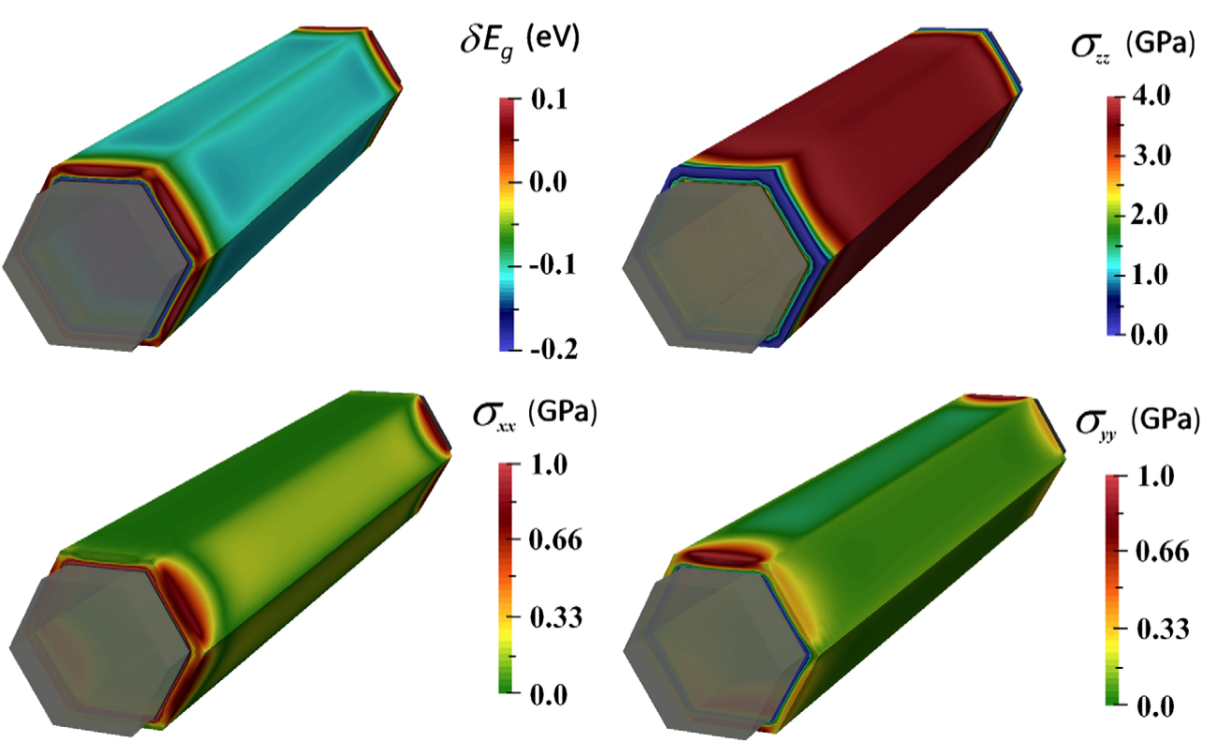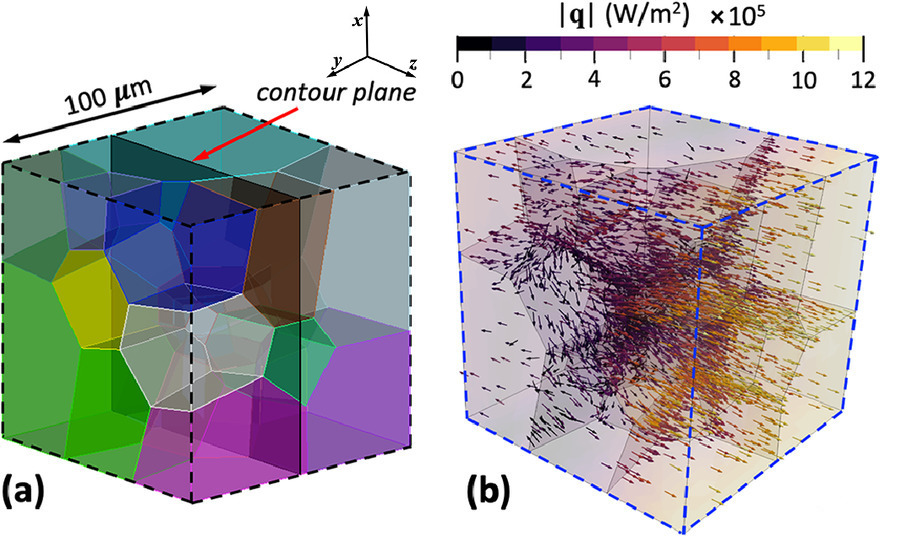Publication Highlights (2015-present):
If you use FERRET for your work and would like your paper(s) to be highlighted on this website, please contact the developers to provide the relevant information. The following papers utilizing the FERRET/MOOSE tool package are highlighted below:

John Mangeri, Olle Heinonen, Dmitry Karpeyev, and Serge Nakhmanson
"Influence of Elastic and Surface Strains on the Optical Properties of Semiconducting Core-Shell Nanoparticles"
Core-shell nanoparticle systems of - and \mathrm{TiO}_2$ are studied computationally using finite-element methods. The inclusion of a surface free energy and the elastic mismatch of the core and shell create an imprinting effect within the shell structure that produces a wide variation of strains. Due to this diversity of strains, the sharp, direct, band-gap edges of the bulk semiconductor are observed to be broadened. We show that a variety of factors, such as particle size, core-to-shell volume ratio, applied hydrostatic pressure, shell microstructure, as well as the effect of elastic anisotropy, can influence the distribution of optical band-gap values throughout the particle.
Received 29 April 2015, Published 7 July 2015

Daopei Zhu, John Mangeri, Ruolin Wang, and Serge Nakhmanson
"Size, shape, and orientation dependence of the field-induced behavior in ferroelectric nanoparticles",
Ferroelectric-dielectric composite materials are attractive for a range of applications in future functional devices. Here, we utilized a free energy based computational approach to investigate the electric-field driven response of isolated ferroelectric nanoparticles embedded in a dielectric matrix and its dependence on particle size, shape, and orientation of the applied field . Particle shapes belonging to the superellipsoidal family were considered, including octahedral, spherical, and cuboidal structures, as well as a number of intermediate geometries. Perovskite and , respectively, were chosen as the prototypical ferroelectric and dielectric materials. In particles of all shapes that are large enough to support domain walls at zero applied field, we observed polarization switching by a formation of intermediate phases, which possess an appreciable amount of vorticity stemming from the domain wall motion through the ferroelectric inclusion volume. The system coercive field and energy storage efficiency were found to be strongly dependent on the particle shape and the orientation, but not on its size. In near spherical particles with easy polarization axis pointing away from the direction of , smallest and highest storage efficiencies were obtained, while nonspherical particles with aligned easy polarization and directions exhibited highest and relatively low energy storage efficiencies.

Joonkyu Park, John Mangeri, Qingteng Zhang, M. Humed Yusuf, Anastasios Pateras, Matthew Dawber, Martin V. Holt, Olle G. Heinonen, Serge Nakhmanson, and Paul G. Evans
"Domain alignment within ferroelectric/dielectric / superlattice nanostructure"
The ferroelectric domain pattern within lithographically defined / ferroelectric/dielectric heteroepitaxial superlattice nanostructures is strongly influenced by the edges of the structures. Synchrotron X-ray nanobeam diffraction reveals that the spontaneously formed ferroelectric stripe domains exhibited by such superlattices adopt a configuration in rectangular nanostructures in which domain walls are aligned with long patterned edges. The angular distribution of X-ray diffuse scattering intensity from nanodomains indicates that domains are aligned within an angular range of approximately 20° with respect to the edges. Computational studies based on a time-dependent Landau–Ginzburg–Devonshire model show that the preferred direction of the alignment results from lowering of the bulk and electrostrictive contributions to the free energy of the system due to the release of the lateral mechanical constraint. This unexpected alignment appears to be intrinsic and not a result of distortions or defects caused by the patterning process. Our work demonstrates how nanostructuring and patterning of heteroepitaxial superlattices allow for pathways to create and control ferroelectric structures that may appear counterintuitive.

Krishna Chaitanya Pitike, John Mangeri, Hope Whitelock, Tulsi Patel, Pamela Dyer, S. Pamir Alpay, and Serge Nakhmanson
"Metastable vortex-like polarization textures in ferroelectric nanoparticles of different shapes and sizes"
The dependence of the polarization texture topology in ferroelectric $\mathrm{PbTiO}_3 nanoparticles, embedded in a dielectric matrix, on the particle shape and size was investigated with a time-dependent Landau-Ginzburg-Devonshire approach combined with coupled-physics finite-element-method based simulations. Particle shapes belonging to the superellipsoidal family were probed,including octahedral, cubic, and intermediate geometries. For each shape, a parametric sweep of particle sizes ranging from 2 to 40 nm was conducted, revealing a general trend for the texture transformations from a monodomain, through a vortex-like, to a multidomain state, as the size increases. Critical particle sizes for the texture instabilities were found to be strongly dependent on the particle shape, with octahedral particles undergoing transitions at much larger volumes, compared to the cubic particles. Furthermore, for each of the considered non-spherical shapes of appro- priate size, it was possible to obtain multiple vortex-like textures whose paraelectric cores are aligned with every rotational axis of the particle point symmetry group. The shape-dependent meta- stability of the vortex-like textures opens up new avenues for controlling polarization at the nanoscale in a variety of technological applications.

"Harnessing ferroelectric domains for negative capacitance"
I. Luk'yanchuk, Y. Tikhonov, A. Sené, A. Razumnaya, and V. M. Vinokur
A pressing quest for overcoming Boltzmann tyranny in low-power nanoscale electronics ignited an extensive search for the devices possessing the negative circuit constants. The emergent concept of the ferroelectric-based negative capacitance triggered then the explosive activity in the field. However, most of the research addressed transient negative capacitance, leaving the basic question of the existence of the steady-state negative capacitance unresolved. Here, we show that the ferroelectric nanodot capacitor hosts a stable two-domain state realizing the static reversible negative capacitance device thus opening routes for the extensive use of the negative capacitance in domain wall-based nanoelectronics.

Lukasz Kuna, John Mangeri, Pu-Xian Gao, and Serge Nakhmanson
"Stress-induced shift of band gap in ZnO nanowires from finite-element modeling"
Attractive mechanical, optical, and electronic properties of semiconducting ZnO nanowires make them prime candidates for a variety on energy-harvesting technologies, including photovoltaics and piezoelectric nanogenerators. In order to enhance the efficiency and versatility of such devices, it is paramount to elucidate the connections between the different property realms, i.e., to establish how mechanical distortions can affect the electronic and optical response of the nanowires, depending on their size, shape, and morphology. For example, it was recently demonstrated that band-gap downshifts of up to -0.1 eV can be induced in monolithic ZnO nanowires by an application of tensile strain - see Wei et al., Nano Lett. 12, 4595 (2012). Here, we conduct mesoscale-level, finite-element-method-based modeling of the coupled elastic and electronic properties of both already-synthesized monolithic ZnO nanowires and yet-to-be-fabricated Zn-ZnO core-shell structures with diameters ranging from 100 to 800 nm. Our investigation suggests that, after an optimization of the size, shape, and mutual crystallographic orientations of the core and shell regions, core-shell nanowires can exhibit downward band-gap shifts of up to -0.3 eV (i.e., approximately 10% of the stress-free ZnO band-gap value) under tensile distortions, which can greatly expand the utility of such nanostructures for optoelectronic applications.

"Topological phase transformations and intrinsic size effects in ferroelectric nanoparticles"
John Mangeri, Yomery Espinal, Andrea Jokisaari, S. Pamir Alpay, Serge Nakhmanson, and Olle Heinonen
Composite materials comprised of ferroelectric nanoparticles in a dielectric matrix are being actively investigated for a variety of functional properties attractive for a wide range of novel electronic and energy harvesting devices. However, the dependence of these functionalities on shapes, sizes, orientation and mutual arrangement of ferroelectric particles is currently not fully understood. In this study, we utilize a time-dependent Ginzburg-Landau approach combined with coupled-physics finite-element-method based simulations to elucidate the behavior of polarization in isolated spherical or nanoparticles embedded in a dielectric medium, including air. The equilibrium polarization topology is strongly affected by particle diameter, as well as the choice of inclusion and matrix materials, with monodomain, vortex-like and multidomain patterns emerging for various combinations of size and materials parameters. This leads to radically dif- ferent polarization vs electric field responses, resulting in highly tunable size-dependent dielectric properties that should be possible to observe experimentally. Our calculations show that there is a critical particle size below which ferroelectricity vanishes. For the particle, this size is 2 and 3.4 nm, respectively, for high- and low-permittivity media. For the particle, it is ~3.6 nm regardless of the medium dielectric strength.

Dharma Basaula, Mohamad Daeipour, Lukasz Kuna, John Mangeri, Boris Feygelson, and Serge Nakhmson
"Towards modeling thermoelectric properties of anisotropic polycrystalline materials"
We report on the development of a finite element method based computational framework for evaluating thermoelectric properties of polycrystalline nanostructured materials and composites at mesoscale. This effort was advanced by formulation, testing and (if possible) validation of thermoelectric ‘benchmark problems,’ that progressed from simple to more advanced cases. The following benchmark problems were investigated: (a) effective Seebeck effect in a thermocouple, (b) Peltier heating and cooling at a single interface between two materials with different Seebeck coefficients, (c) coupled heat and electrical current transport through an anisotropic polycrystalline material. Excellent agreement with prior experimental or computational results was observed for the cases (a) and (b). The developed framework establishes the capabilities necessary to elucidate the workings of thermoelectric effects at the mesoscale level and could provide new opportunities for improvement of operational efficiency of nanoengineered thermoelectric materials and composites.

Yu. Tikhonov, S. Kondovych, J. Mangeri, M. Pavlenko, L. Baudry, A. Sené, A. Galda, S. Nakhmanson, O. Heinonen, A. Razumnaya, I. Luk'yanchuk, and V. M. Vinokur
"Controllable skyrmion chirality in ferroelectrics"
Chirality, an intrinsic handedness, is one of the most intriguing fundamental phenomena in nature. Materials composed of chiral molecules find broad applications in areas ranging from nonlinear optics and spintronics to biology and pharmaceuticals. However, chirality is usually an invariable inherent property of a given material that cannot be easily changed at will. Here, we demonstrate that ferroelectric nanodots support skyrmions the chirality of which can be controlled and switched. We devise protocols for realizing control and efficient manipulations of the different types of skyrmions. Our findings open the route for controlled chirality with potential applications in ferroelectric-based information technologies.
The full reverse chronological list of publications (20) that have used FERRET are provided below:
"Extrinsic dielectric response due to domain wall motion in ferroelectric BaTiO3", Comp. Mater. Today, 5, 100016, (2024)
"Ferroelectric Texture of Individual Barium Titanate Nanocrystals", ACS Nano., 18, 28, (2024)
"Manipulating chiral spin transport with ferroelectric polarization", Nature Mater., 23, 898-904, (2024)
"Predicting thermoelectric figure of merit in complex materials: What do we need to know?", Acta Materialia, 271, 119889, (2024)
"Modeling structure–properties relations in compositionally disordered relaxor dielectrics at the nanoscale", J. Appl. Phys., 134, 10, (2023)
"Coupled magnetostructural continuum model for multiferroic BiFeO3", Phys. Rev. B 108, 094101 (2023)
"Towards modeling thermoelectric properties of anisotropic polycrystalline materials", Acta Materialia, 228, 117743, (2022)
"Surface charge mediated polar response in ferroelectric nanoparticles", Appl. Phys. Lett. 119, 26, (2021)
"Hopfions emerge in ferroelectrics", Nature Comm. 11, 2433 (2020)
"Mesoscale modeling of light transmission modulation in ceramics", Acta Materialia, 193, 261-269, (2020)
"Controllable skyrmion chirality in ferroelectrics", Sci. Rep. 10, 8657, (2020)
"Size, shape and crystallographic orientation dependence of the field-induced behavior in ferroelectric nanoparticles", J. Appl. Phys. 125, 134102, (2019)
"Harnessing ferroelectric domains for negative capacitance", Communications Physics 2 (1), 1-6, (2019)
"Mesoscale modeling of polycrystalline light transmission", Acta Materialia, 175, 82-89, (2019)
"Electromechanical control of polarization vortex ordering in an interacting ferroelectric-dielectric composite dimer", Appl. Phys. Lett. 113, 092901, (2018)
"Metastable vortex-like polarization textures in ferroelectric nanoparticles of different shapes and sizes", J. Appl. Phys. 124, 064104, (2018)
"Domain alignment within ferroelectric/dielectric / superlattice nanostructure", Nanoscale, 10, 3262-3271, (2018)
"Topological phase transformations and intrinsic size effects in ferroelectric nanoparticles", Nanoscale, 9, 1616-1624, (2017)
"Stress-induced shift of band gap in ZnO nanowires from finite-element modeling", Phys. Rev. Appl. 8, 034031, (2017)
"Influence of Elastic and Surface Strains on the Optical Properties of Semiconducting Core-Shell Nanoparticles", Phys. Rev. Appl., 4, 014001, (2015)